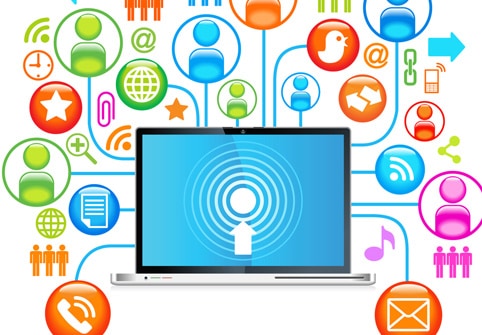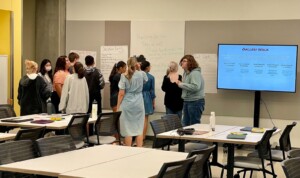10 Innovative & Practical Applications of SMART Tech

Guest blogger Brady Phillips joins us today to share 10 ways to incorporate SMART Boards and Notebooks in the classroom.
“Would you tell me, please, which way I ought to go from here?” asked Alice in Wonderland. That depends a great deal on where you want to get to” replied the Cheshire Cat.
“Ask not what your SMART Board can do; ask instead what you can do with your SMART Board.”
– Apologies to John F. Kennedy
 Both of the above quotes come to mind when I am asked, “What does a SMART Board interactive whiteboard do?” The answer is, “Pretty much anything you want it to.” The brush is only as powerful as the imagination and talent of the painter. Creative teachers and skilled artisans share the skill of being able to use the tools they are given to create magic. Good teaching trumps good technology all day long. What good technology can do is enhance and enrich teaching and learning. Using technology for technologies’ sake, electronic traditionalism if you will, lends little to the evolutionary process. If, however, the technology is used to personalize learning through differentiation, support cooperation and collaboration and create experiences otherwise absent, or too difficult or expensive, then we have hit the sweet spot Scott Noon refers to as “Technoconstructivism.”
Both of the above quotes come to mind when I am asked, “What does a SMART Board interactive whiteboard do?” The answer is, “Pretty much anything you want it to.” The brush is only as powerful as the imagination and talent of the painter. Creative teachers and skilled artisans share the skill of being able to use the tools they are given to create magic. Good teaching trumps good technology all day long. What good technology can do is enhance and enrich teaching and learning. Using technology for technologies’ sake, electronic traditionalism if you will, lends little to the evolutionary process. If, however, the technology is used to personalize learning through differentiation, support cooperation and collaboration and create experiences otherwise absent, or too difficult or expensive, then we have hit the sweet spot Scott Noon refers to as “Technoconstructivism.”
The SMART Board and SMART Notebook software collaborative learning software are tools that can be used for whole class, small group and individual learning. The below list includes creative ways I have seen the SMART Board used.
1. Small Group/Center Formative Assessment
The best SMART Board is a “sticky” SMART Board. Sticky because it has had kid’s hands all over it. Students working in small groups at the SMART Board as part of a rotation of learning centers in can be used for practice and reinforcement. Notebook software’s Lesson Activity Tool Kit includes customizable flash-based templates that can be used as check for understanding and guide instruction.
2. Virtual Experiences
Some experiences are too expensive or too dangerous to do “for real.” Within Notebook there are 3D objects and virtual manipulatives that allow “hands-on’ish” exploration. There are third-party websites such as Energy Skate Park where students can learn from and with each other and the experience is enhanced by the SMART Board.
3. Reteach/Enrich/Remediate
SMART Recorder is a tool that allows anything that is shared on the board, including voice when a microphone is present, to be saved as a video file. Making these files available can help not only students who may miss class, but also those who may be struggling with certain concepts.
4. Flip the Classroom
Several creative instructors are experimenting with flipping the class whereby videos take the place of direct instruction, allowing students to get individual time in class to work with their teacher on key learning activities. It is called the flipped class because what used to be class work (the “lecture” is done at home via teacher-created videos and what used to be homework assigned problems) is now done in class. SMART Recorder allows teachers to capture direct instruction with one-touch simplicity.
5. Abstract Made More Concrete
SMART Notebook software has an available Math Tools plug-in to quickly create visual representations of a wide range of concepts from elementary school fractions to algebraic functions in AP calculus & HS science courses. These visuals can help students understand abstract concepts by representing them more concretely. Similarly, Notebook has the ability to display 3D objects, some of which are included in the gallery, others available for free download from the Google 3D image library. These images, when paired with a mixed-reality ready document camera, like the SMART Document Camera, allow the manipulation of objects in space from all angles.
6. Enhances Concrete, Representational, Abstract (CRA) Instructional Approach for Mathematics
There is an elegance and agility as the SMART Board accommodates all three with phases without having to change presentation tools as you would in more traditional spaces. In this model of instruction, young mathematicians use concrete materials to manipulate to solve problems, the SMART Board with the SMART Document Camera help teachers use those materials in their true form vs. overheads which require special transparent objects to do the same. Kids are using the same materials at their seats that teachers use beneath the document camera. In the representational phase, virtual objects such as drawings and pictures are used. The Notebook Gallery has thousands of virtual manipulatives teachers can use with students as they begin representing equations. Finally, the abstract phase involves the use of operational symbols and written equations. SMART Notebook Math Tools software includes an equation editor that allows teachers and students to manipulate numbers and see these graphically represented. Please visit Teaching With SMART Board and Harvey’s Homepage to see some examples.
7. This Board is Your Board…Not So Much My Board
Students learn by doing. Having teachers get out of the way and let the students use the SMART Board and Notebook software to demonstrate understanding of a concept or problem should be at the center of pedagogy. Granted, perhaps only a few students can be directly engaged at the board at a given time, however there is value in peer-teaching and the opportunity to develop presentation skills and sharing with a group. Cooperation and collaboration are fostered and enhanced when students can work with one another versus being passive participants.
8. Interactive Canvas in Notebook
STEM (Science, Technology, Engineering, Math) is vitally important, but I like to think of it in terms of “STEAM” and the A stands for Arts. In the Art classroom, the SMART Board becomes an interactive canvas using another tool called ArtRage. Since the SMART Board is not pen-dependent, students can use a wide variety of real brushes coupled with the software brushes to paint, draw, explore color, etc. These paintings can be the illustrations for original books. Notebook software allows students to create and author stories to compliment their art as it is ideally suited for both text and drawings. Notebook software also allows direct import into PDF format so their books can now be read using any computer, such as Kindle, most eReaders, iPads and iPod touches. Students absolutely love the fact that their work is digital and can be shared with readers across the world.
9. Enhanced Lecture
As a predominantly constructivist teacher, there were times I suffered from “lecture guilt”. However, there are times when – dare I say it – the best way to help students learn is to actually teach them explicitly, via direct instruction. There are tools within Notebook software such as SMART Video Player that enable the SMART Board to become a media hub of sorts. The seamless integration of third-party audio and video resources can serve to differentiate instruction and appeal to multiple intelligences for those times when direct instruction is appropriate.
10. Electronic Professional Learning Communities
Admittedly, this suggestion appears to be out of place in a list of creative ways to use a SMART Board. However, I like a quote from James Surowiecki’s Wisdom of Crowds; “And much of what we’ve seen so far suggests that a large group of diverse individuals will make more intelligent decisions than even the most skilled decision maker.”
Put another way, there are brilliant, creative educators who are doing incredible things with their SMART Boards. However, the skill and expertise of any one SMART Board guru is dwarfed by the collective wisdom of the crowd. Technology blows the walls off the school and makes professional sharing possible. Visit the SMART Exchange website and search thousands of lessons created by classroom teachers and well-known education publishers that you can use whole cloth or customize to use with your students. The Exchange also contains a forum where you can connect and create your own User Groups.
There are other terrific resources such as SMART Board Revolution that allow you to collaborate by sharing ideas, and tips in an effort to maximize our students’ learning. Whether it be in your building, your district or an on-line community, connecting with other educators and having the confidence to share and the humility to learn is essential in moving teaching practice forward.
Please note the above list is not meant to be exhaustive nor prescriptive. Hopefully you find it helpful. I would love to hear other examples of creative ways you’re using your SMART Board.
—
Brady Phillips began working with SMART in 2007 as Manager, North American Education Consulting, and is currently Manager, Education Practice.







Donna Fabre
Fantastic post from this guest author. Smart tech has many advantages (and disadvantages, let's not be biased) within an array of different settings. One of the most useful being within classrooms, where they have been shown to improve engagement from pupils who are learning new things